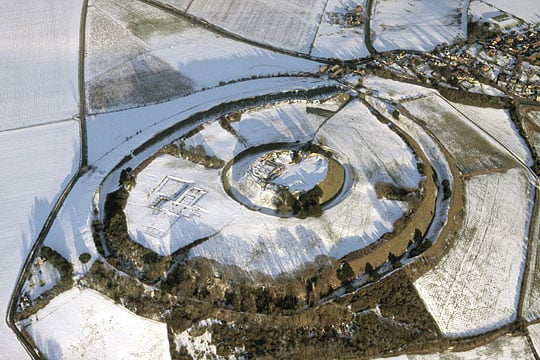Description of Old Sarum
There are three main points of interest at Old Sarum: the earthworks of the Iron Age hillfort, the inner stronghold of the Norman castle on the motte at its centre, and the remains of the cathedral within the north-west quarter of the hillfort.

Earthworks
Little standing masonry survives at Old Sarum, but the earthworks are mostly well preserved. The original Iron Age enclosure was defined by an outer rampart which exploits the underlying topography, so that the height and angle of the banks simply exaggerate the natural shape of the promontory.
The enclosure seems to have had a single entry from the east, protected by a ditch and a type of bank known as a hornwork, most of which still survives, and which remains the main entrance to the site.
This outer rampart encloses an area of approximately 12ha – larger than the vast majority of Iron Age hillforts, but still only just over half the size of the greatest of them, Maiden Castle (Dorset). Within this there is a second circular ditch and rampart, built for William the Conqueror to enclose the late 11th-century castle.
The Castle
The inner bailey was excavated in 1909–12. It is approached via a modern wooden bridge over the bailey ditch through the remains of a 12th-century gatehouse. Within and to the west are the ruined shell of the keep, or great tower, with the remains of the courtyard house to the north.
The courtyard house consists of four ranges arranged around a small courtyard and was originally built on two levels, with an eastern service range (the kitchen tower and associated cesspits rise up the bank to the north).
The south range housed a two-storey chapel, whose upper storey was dedicated to St Nicholas and lower storey to St Margaret. The west range was a hall, while the north range was for the use of the king, with deep latrine pits added for private bathrooms. The tiny courtyard is now a lawn, though it is likely there would have been wooden pentices (covered walks) on two sides.
The Cathedral
The plan of the cathedral as uncovered in excavations between 1912 and 1915 is marked out on the ground in cement. The first cathedral was small, a mere 56m from apse to west end, with three apses, a narrow transept with transept chapels and a regular crossing.
This cathedral was then extended by Bishop Roger (1102–39), who was responsible for new transepts, a larger choir and presbytery, and a vestry/treasury building to the north.
West of the crossing are the remains of the pulpitum screen created under Bishop Jocelyn (1142–84), which screened the ritual choir from the nave. The principal entrance for the laity was via a porch attached to the south transept. East of the north transept, steps lead down into the former cloister, where a beautifully preserved section of external walling survives, giving a rare glimpse of the exquisite finish of Roger's cathedral.
The cloister itself was never fully dug out in 1912–15, though the four walks can be seen on the ground. The bishop's palace lay beyond the north cloister walk, with a hall and garden to its west. The archaeologists discovered evidence for two phases of work, the second of which had an aisled hall and ancillary ranges around a courtyard.
This is similar to the great Wolvesey Palace of the Bishops of Winchester, though Old Sarum seems to pre-date this, and is probably the earliest of its type.
READ MORE ABOUT OLD SARUM